warning Acura MDX 2015 Service Manual
[x] Cancel search | Manufacturer: ACURA, Model Year: 2015, Model line: MDX, Model: Acura MDX 2015Pages: 79, PDF Size: 16.44 MB
Page 62 of 79
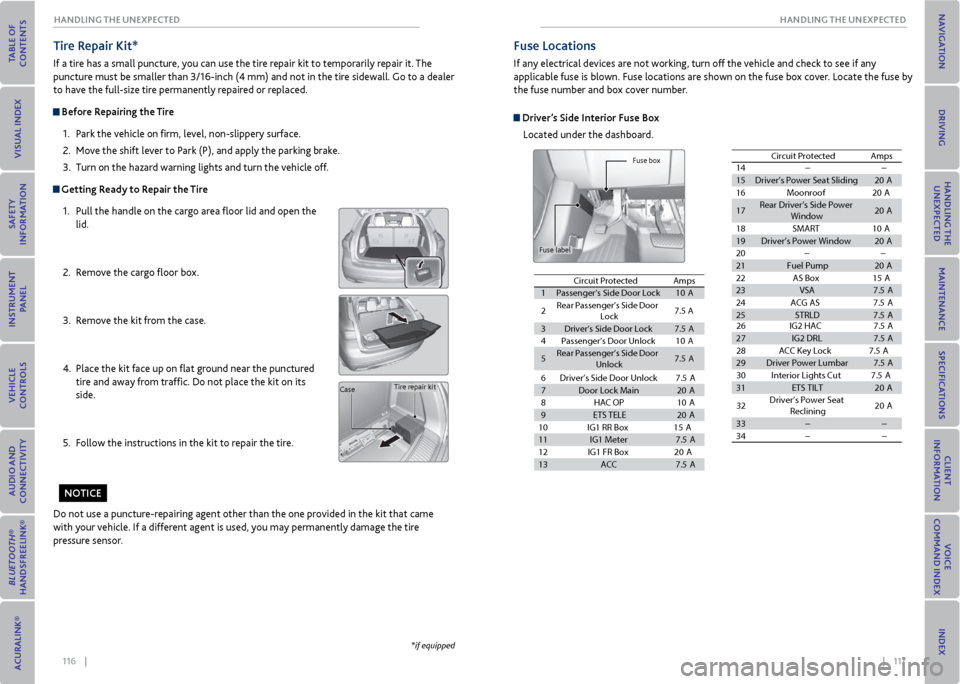
116 || 117
HANDLING THe UNexPeCTeD
HANDLING THe UNexPeCTeD
Tire r epair Kit*
If a tire has a small puncture, you can use the tire repair kit to temporarily repair it. The
puncture must be smaller than 3/16-inch (4 mm) and not in the tire sidewall. Go to a dealer
to have the full-size tire permanently repaired or replaced.
Before r epairing the Tire
1. Park the vehicle on firm, level, non-slippery surface.
2. Move the shift lever to Park (P), and apply the parking brake.
3. Turn on the hazard warning lights and turn the vehicle off.
Getting ready to repair the Tire
1. Pull the handle on the cargo area floor lid and open the
lid.
2. Remove the cargo floor box.
3. Remove the kit from the case.
4. Place the kit face up on flat ground near the punctured
tire and away from traffic. Do not place the kit on its
side.
5. Follow the instructions in the kit to repair the tire.
Do not use a puncture-repairing agent other than the one provided in the kit that came
with your vehicle. If a different agent is used, you may permanently damage the tire
pressure sensor.
Tire repair kit
Case
*if equipped
No TICe
Fuse Locations
If any electrical devices are not working, turn off the vehicle and check to see if any
applicable fuse is blown. Fuse locations are shown on the fuse box cover. Locate the fuse by
the fuse number and box cover number.
Driver’s Side Interior Fuse Box
Located under the dashboard.
Fuse box
Fuse label
Circuit ProtectedAmps
1Passenger’s Side Door Lock10 A
2Rear Passenger’s Side Door
Lock7.5 A
3Driver’s Side Door Lock7.5A
4Passenger’s Door Unloc k10A
5Rear Passenger’s Side Door Unlock7.5A
6 Driver’s Side Door Unlock 7.5A
7 Door Lock Main 20A
8 HAC OP 10A
9 ETS TELE 20A
10 IG1 RR Box1 5A
11 IG1 Meter 7.5A
12 IG1 FR Box2 0A
13 ACC 7.5A
14 ��
15 Driver’s Power Seat Sliding 20A
16 Moonroof 20A
17 Rear Driver’s Side Power
Window 20
A
18 SMART 10A
19 Driver’s Power Windo w20A
20 ��
21 Fuel Pump 20A
22 AS Box 15A
23 VSA 7.5A
24 ACG AS 7.5A
25 STRLD 7.5A
Circuit Protecte
dAmps
26 IG2 HAC 7.5A
27 IG2 DRL 7.5A
28 ACC Key Lock 7.5A
29 Driver Power Lumbar 7.5A
30 Interior Lights Cut 7.5A
31 ETS TILT 20A
32 Driver’s Power Seat
Reclining 20
A
33 � �
34 � �
Circuit Protected
Amps
Circuit Protected Amps
1 Passenger’s Side Door Lock 10A
2 Rear
Passenger’s Side Door
Lock 7.5
A
3 Driver’s Side Door Lock 7.5A
4 Passenger’s Door Unloc k10A
5 Rear
Passenger’s Side Door
Unlock 7.
5A
6Driver’s Side Door Unlock7.5A
7Door Lock Main20 A
8HAC OP10A
9ETS TELE20A
10 IG1 RR Bo
x15A
11IG1 Meter7.5A
12 IG1 FR Bo
x20A
13ACC7.5A
14 ��
15 Driver’s Power Seat Sliding 20A
16 Moonroof 20A
17 Rear Driver’s Side Power
Window 20
A
18 SMART 10A
19 Driver’s Power Windo w20A
20 ��
21 Fuel Pump 20A
22 AS Box 15A
23 VSA 7.5A
24 ACG AS 7.5A
25 STRLD 7.5A
Circuit Protecte dAmps
26IG2 HAC 7.5A
27 IG2 DRL 7.5A
28 ACC Key Lock 7.5A
29 Driver Power Lumbar 7.5A
30 Interior Lights Cut 7.5A
31 ETS TILT 20A
32 Driver’s Power Seat
Reclining 20
A
33 � �
34 � �
Circuit Protected
Amps
Circuit Protected Amps
1 Passenger’s Side Door Lock 10A
2 Rear
Passenger’s Side Door
Lock 7.5
A
3 Driver’s Side Door Lock 7.5A
4 Passenger’s Door Unloc k10A
5 Rear
Passenger’s Side Door
Unlock 7.
5A 6
Driver’s Side Door Unlock 7.5A
7 Door Lock Main 20A
8 HAC OP 10A
9 ETS TELE 20A
10 IG1 RR Box1 5A
11 IG1 Meter 7.5A
12 IG1 FR Box2 0A
13 ACC 7.5A
14 ��
15 Driver’s Power Seat Sliding 20A
16 Moonroof 20A
17 Rear Driver’s Side Power
Window 20
A
18 SMART 10A
19 Driver’s Power Windo w20A
20 ��
21 Fuel Pump 20A
22 AS Box 15A
23 VSA 7.5A
24 ACG AS 7.5A
25 STRLD 7.5A
Circuit Protecte
dAmps
26 IG2 HAC 7.5A
27IG2 DR L7.5A
28 ACC Key Lock 7.5A
29Driver Power Lumbar7.5A
30 Interior Lights Cut 7.5A
31ETS TILT20 A
32 Driver’s Power Seat
Reclining 20
A
33��
34��
Circuit ProtectedAmps
Circuit Protected Amps
1 Passenger’s Side Door Lock 10A
2 Rear
Passenger’s Side Door
Lock 7.5
A
3 Driver’s Side Door Lock 7.5A
4 Passenger’s Door Unloc k10A
5 Rear
Passenger’s Side Door
Unlock 7.
5A 6
Driver’s Side Door Unlock 7.5A
7 Door Lock Main 20A
8 HAC OP 10A
9 ETS TELE 20A
10 IG1 RR Box1 5A
11 IG1 Meter 7.5A
12 IG1 FR Box2 0A
13ACC7.5A
14 ��
15Driver’s Power Seat Sliding20A
16 Moonroof 20A
17Rear Driver’s Side Power
Window20A
18 SMART 10A
19Driver’s Power Windo w20A
20
��
21Fuel Pump20 A
22 AS Box 15A
23VSA7.5A
24 ACG AS 7.5A
25STRLD7.5A
Circuit Protecte
dAmps
26 IG2 HAC 7.5A
27 IG2 DRL 7.5A
28 ACC Key Lock 7.5A
29 Driver Power Lumbar 7.5A
30 Interior Lights Cut 7.5A
31 ETS TILT 20A
32 Driver’s Power Seat
Reclining 20
A
33 � �
34 � �
Circuit Protected
Amps
Circuit ProtectedAmps
1Passenger’s Side Door Lock10A
2 Rear
Passenger’s Side Door
Lock 7.5
A
3 Driver’s Side Door Lock 7.5A
4 Passenger’s Door Unloc k10A
5 Rear
Passenger’s Side Door
Unlock 7.
5A6 Driver’s Side Door Unlock 7.5A
7 Door Lock Main 20A
8 HAC OP 10A
9 ETS TELE 20A
10 IG1 RR Box1 5A
11 IG1 Meter 7.5A
12 IG1 FR Box2 0A
13 ACC 7.5A
14 ��
15 Driver’s Power Seat Sliding 20A
16 Moonroof 20A
17 Rear Driver’s Side Power
Window 20
A
18 SMART 10A
19 Driver’s Power Windo w20A
20 ��
21 Fuel Pump 20A
22 AS Box 15A
23 VSA 7.5A
24 ACG AS 7.5A
25 STRLD 7.5A
Circuit Protecte
dAmps
26 IG2 HAC 7.5A
27 IG2 DRL 7.5A
28 ACC Key Lock 7.5A
29 Driver Power Lumbar 7.5A
30 Interior Lights Cut 7.5A
31 ETS TILT 20A
32 Driver’s Power Seat
Reclining 20
A
33 � �
34 � �
Circuit Protected
Amps
Page 64 of 79
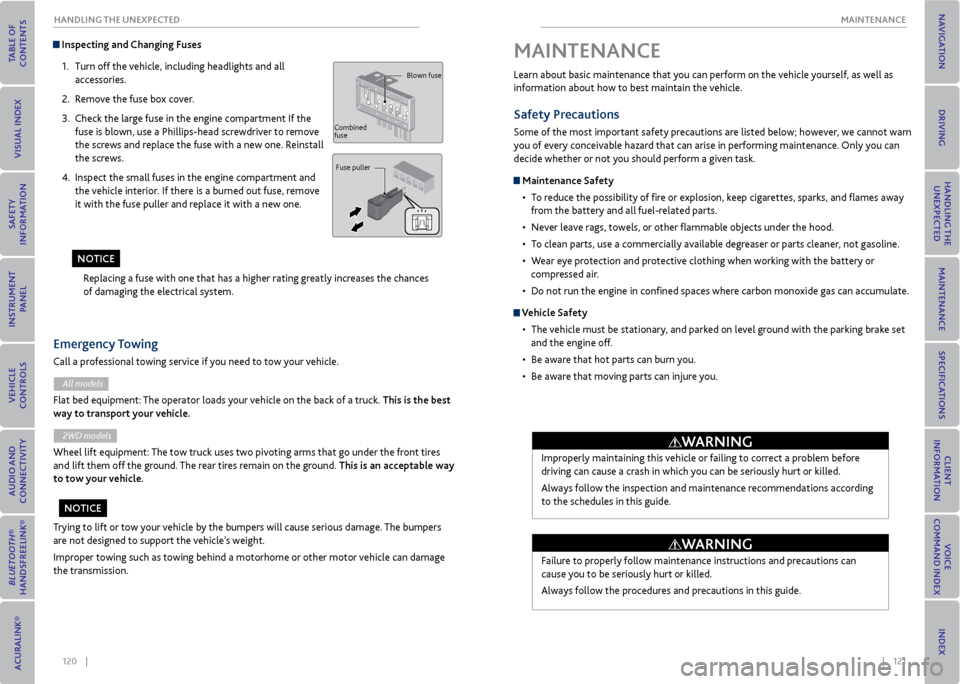
120 || 121
mAINTeNANCe
HANDLING THe UNexPeCTeD
Inspecting and Changing Fuses
1. Turn off the vehicle, including headlights and all
accessories.
2. Remove the fuse box cover.
3. Check the large fuse in the engine compartment If the
fuse is blown, use a Phillips-head screwdriver to remove
the screws and replace the fuse with a new one. Reinstall
the screws.
4. Inspect the small fuses in the engine compartment and
the vehicle interior. If there is a burned out fuse, remove
it with the fuse puller and replace it with a new one.
Replacing a fuse with one that has a higher rating greatly increases the chances
of damaging the electrical system.
Blown fuse
Combined
fuse Fuse puller
Trying to lift or tow your vehicle by the bumpers will cause serious damage. The bumpers
are not designed to support the vehicle’s weight.
Improper towing such as towing behind a motorhome or other motor vehicle can damage
the transmission.
emergency Towing
Call a professional towing service if you need to tow your vehicle.
All models
Flat bed equipment: The operator loads your vehicle on the back of a truck. This is the best
way to transport your vehicle.
2WD models
Wheel lift equipment: The tow truck uses two pivoting arms that go under the front tires
and lift them off the ground. The rear tires remain on the ground. This is an acceptable way
to tow your vehicle.
No TICe
NoTICe Learn about basic maintenance that you can perform on the vehicle yourself, as well as
information about how to best maintain the vehicle.
Safety Precautions
Some of the most important safety precautions are listed below; however, we cannot warn
you of every conceivable hazard that can arise in performing maintenance. Only you can
decide whether or not you should perform a given task.
maintenance Safety
• To reduce the possibility of fire or explosion, keep cigarettes, sparks, and flames away
from the battery and all fuel-related parts.
• Never leave rags, towels, or other flammable objects under the hood.
• To clean parts, use a commercially available degreaser or parts cleaner, not gasoline.
• Wear eye protection and protective clothing when working with the battery or
compressed air.
• Do not run the engine in confined spaces where carbon monoxide gas can accumulate.
vehicle Safety
• The vehicle must be stationary, and parked on level ground with the parking brake set
and the engine off.
• Be aware that hot parts can burn you.
• Be aware that moving parts can injure you.
mAINTeNANCe
Improperly maintaining this vehicle or failing to correct a problem before
driving can cause a crash in which you can be seriously hurt or killed.
Always follow the inspection and maintenance recommendations according
to the schedules in this guide.
Failure to properly follow maintenance instructions and precautions can
cause you to be seriously hurt or killed.
Always follow the procedures and precautions in this guide.
WArNING
WArNING
Page 67 of 79
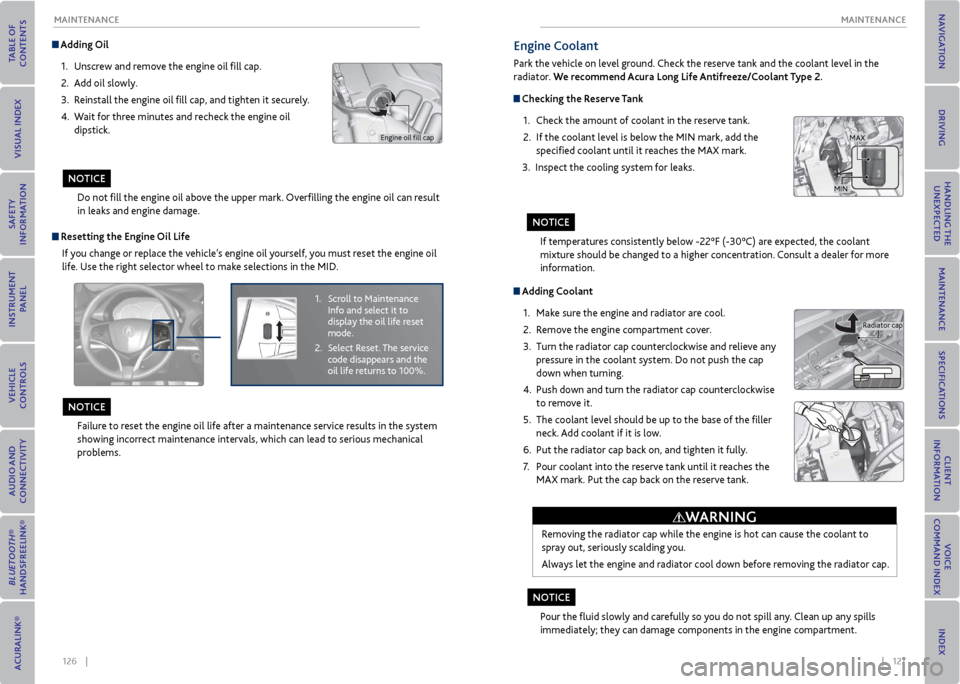
126 || 127
mAINTeNANCe
mAINTeNANCe
Adding oil
1. Unscrew and remove the engine oil fill cap.
2. Add oil slowly.
3. Reinstall the engine oil fill cap, and tighten it securely.
4. Wait for three minutes and recheck the engine oil
dipstick.
Do not fill the engine oil above the upper mark. Overfilling the engine oil can result
in leaks and engine damage.
Engine oil fill cap
r esetting the engine oil Life
If you change or replace the vehicle’s engine oil yourself, you must reset the engine oil
life. Use the right selector wheel to make selections in the MID.
Failure to reset the engine oil life after a maintenance service results in the system
showing incorrect maintenance intervals, which can lead to serious mechanical
problems.
1. Scroll to Maintenance
Info and select it to
display the oil life reset
mode.
2. Select Reset. The service
code disappears and the
oil life returns to 100%.
No TICe
NoTICe
Adding Coolant
1. Make sure the engine and radiator are cool.
2. Remove the engine compartment cover.
3. Turn the radiator cap counterclockwise and relieve any
pressure in the coolant system. Do not push the cap
down when turning.
4. Push down and turn the radiator cap counterclockwise
to remove it.
5. The coolant level should be up to the base of the filler
neck. Add coolant if it is low.
6. Put the radiator cap back on, and tighten it fully.
7. Pour coolant into the reserve tank until it reaches the
MAX mark. Put the cap back on the reserve tank.
Removing the radiator cap while the engine is hot can cause the coolant to
spray out, seriously scalding you.
Always let the engine and radiator cool down before removing the radiator cap.
Pour the fluid slowly and carefully so you do not spill any. Clean up any spills
immediately; they can damage components in the engine compartment.
Radiator cap
WArNING
engine Coolant
Park the vehicle on level ground. Check the reserve tank and the coolant level in the
radiator. We recommend Acura Long Life Antifreeze/Coolant Type 2.
Checking the reserve Tank
1. Check the amount of coolant in the reserve tank.
2. If the coolant level is below the MIN mark, add the
specified coolant until it reaches the MAX mark.
3. Inspect the cooling system for leaks.
If temperatures consistently below -22°F (-30°C) are expected, the coolant
mixture should be changed to a higher concentration. Consult a dealer for more
information.
MAX
MIN
No TICe
NoTICe
Page 68 of 79
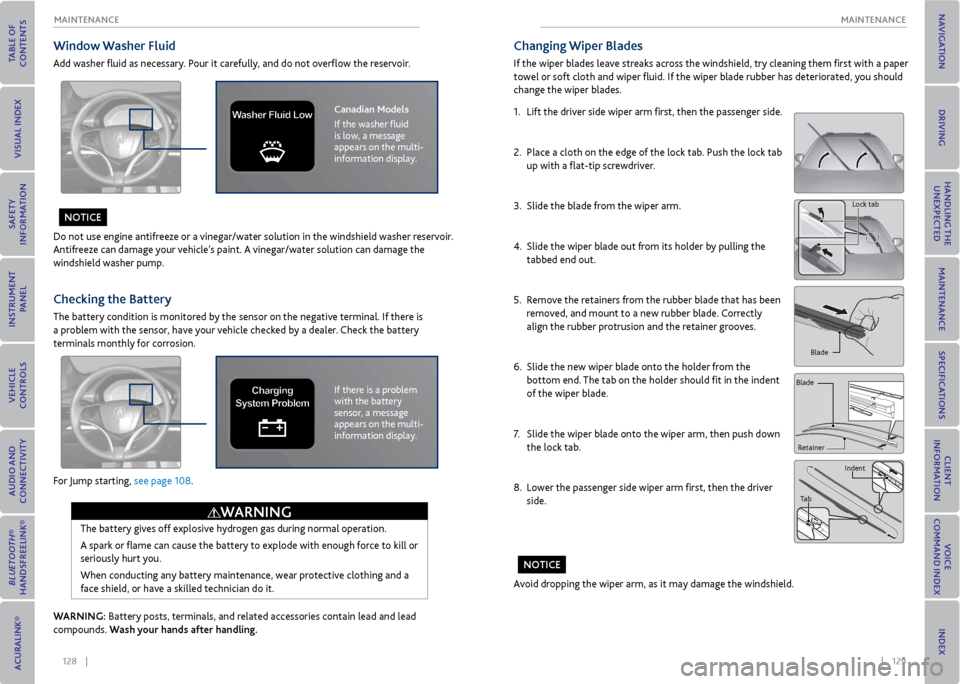
128 || 129
mAINTeNANCe
mAINTeNANCe
Window Washer Fluid
Add washer fluid as necessary. Pour it carefully, and do not overflow the reservoir.
Do not use engine antifreeze or a vinegar/water solution in the windshield washer reservoir.
Antifreeze can damage your vehicle’s paint. A vinegar/water solution can damage the
windshield washer pump.
For Jump starting, see page 108.
Checking the Battery
The battery condition is monitored by the sensor on the negative terminal. If there is
a problem with the sensor, have your vehicle checked by a dealer. Check the battery
terminals monthly for corrosion.
The battery gives off explosive hydrogen gas during normal operation.
A spark or flame can cause the battery to explode with enough force to kill or
seriously hurt you.
When conducting any battery maintenance, wear protective clothing and a
face shield, or have a skilled technician do it.
WArNING
Canadian models
If the washer fluid
is low, a message
appears on the multi-
information display.Washer Fluid Lo w
WArNING: Battery posts, terminals, and related accessories contain lead and lead
compounds. Wash your hands after handling.
If there is a problem
with the battery
sensor, a message
appears on the multi-
information display.Charging
System Problem
No TICe
Changing Wiper Blades
If the wiper blades leave streaks across the windshield, try cleaning them first with a paper
towel or soft cloth and wiper fluid. If the wiper blade rubber has deteriorated, you should
change the wiper blades.
1. Lift the driver side wiper arm first, then the passenger side.
2. Place a cloth on the edge of the lock tab. Push the lock tab
up with a flat-tip screwdriver.
3. Slide the blade from the wiper arm.
4. Slide the wiper blade out from its holder by pulling the
tabbed end out.
5. Remove the retainers from the rubber blade that has been
removed, and mount to a new rubber blade. Correctly
align the rubber protrusion and the retainer grooves.
6. Slide the new wiper blade onto the holder from the
bottom end. The tab on the holder should fit in the indent
of the wiper blade.
7. Slide the wiper blade onto the wiper arm, then push down
the lock tab.
8. Lower the passenger side wiper arm first, then the driver
side.
Lock tab
Blade
Retainer
Blade
Indent
Tab
Avoid dropping the wiper arm, as it may damage the windshield.
No TICe
Page 69 of 79
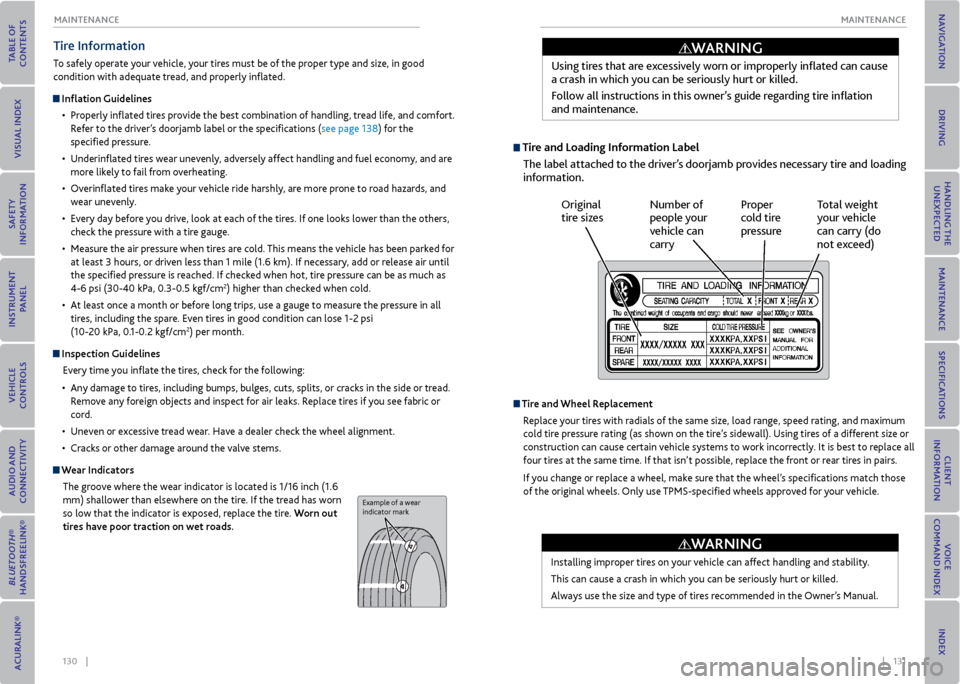
130 || 131
mAINTeNANCe
mAINTeNANCe
Tire Information
To safely operate your vehicle, your tires must be of the proper type and size, in good
condition with adequate tread, and properly inflated.
Inflation Guidelines
• Properly inflated tires provide the best combination of handling, tread life, and comfort.
Refer to the driver’s doorjamb label or the specifications (see page 138) for the
specified pressure.
• Underinflated tires wear unevenly, adversely affect handling and fuel economy, and are
more likely to fail from overheating.
• Overinflated tires make your vehicle ride harshly, are more prone to road hazards, and
wear unevenly.
• Every day before you drive, look at each of the tires. If one looks lower than the others,
check the pressure with a tire gauge.
• Measure the air pressure when tires are cold. This means the vehicle has been parked for
at least 3 hours, or driven less than 1 mile (1.6 km). If necessary, add or release air until
the specified pressure is reached. If checked when hot, tire pressure can be as much as
4-6 psi (30-40 kPa, 0.3-0.5 kgf/cm
2) higher than checked when cold.
• At least once a month or before long trips, use a gauge to measure the pressure in all
tires, including the spare. Even tires in good condition can lose 1-2 psi
(10-20 kPa, 0.1-0.2 kgf/cm
2) per month.
Inspection Guidelines
Every time you inflate the tires, check for the following:
• Any damage to tires, including bumps, bulges, cuts, splits, or cracks in the side or tread.
Remove any foreign objects and inspect for air leaks. Replace tires if you see fabric or
cord.
• Uneven or excessive tread wear. Have a dealer check the wheel alignment.
• Cracks or other damage around the valve stems.
Wear Indicators
The groove where the wear indicator is located is 1/16 inch (1.6
mm) shallower than elsewhere on the tire. If the tread has worn
so low that the indicator is exposed, replace the tire. Worn out
tires have poor traction on wet roads.
Example of a wear
indicator mark
Tire and Loading Information LabelThe label attached to the driver’s doorjamb provides necessary tire and loading
information. Using tires that are excessively worn or improperly inflated can cause
a crash in which you can be seriously hurt or killed.
Follow all instructions in this owner’s guide regarding tire inflation
and maintenance.
Original
tire sizes
Number of
people your
vehicle can
carry Proper
cold tire
pressure
Total weight
your vehicle
can carry (do
not exceed)
Tire and Wheel r eplacement
Replace your tires with radials of the same size, load range, speed rating, and maximum
cold tire pressure rating (as shown on the tire’s sidewall). Using tires of a different size or
construction can cause certain vehicle systems to work incorrectly. It is best to replace all
four tires at the same time. If that isn’t possible, replace the front or rear tires in pairs.
If you change or replace a wheel, make sure that the wheel’s specifications match those
of the original wheels. Only use TPMS-specified wheels approved for your vehicle.
Installing improper tires on your vehicle can affect handling and stability.
This can cause a crash in which you can be seriously hurt or killed.
Always use the size and type of tires recommended in the Owner’s Manual.
WArNING
WArNING
Page 70 of 79
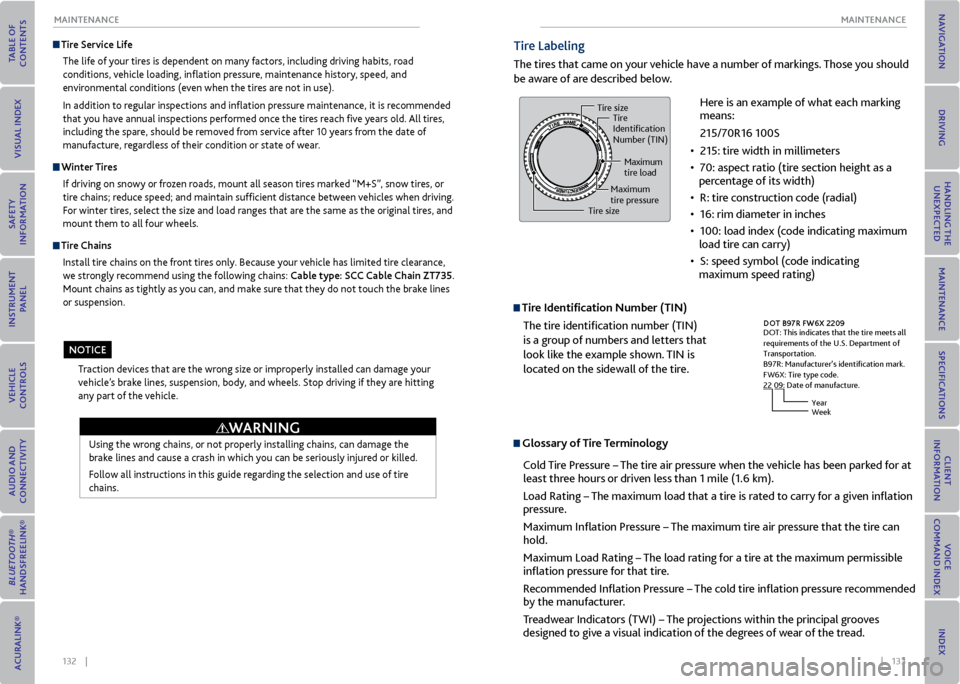
132 || 133
mAINTeNANCe
mAINTeNANCe
Tire Service Life
The life of your tires is dependent on many factors, including driving habits, road
conditions, vehicle loading, inflation pressure, maintenance history, speed, and
environmental conditions (even when the tires are not in use).
In addition to regular inspections and inflation pressure maintenance, it is recommended
that you have annual inspections performed once the tires reach five years old. All tires,
including the spare, should be removed from service after 10 years from the date of
manufacture, regardless of their condition or state of wear.
Winter Tires
If driving on snowy or frozen roads, mount all season tires marked “M+S”, snow tires, or
tire chains; reduce speed; and maintain sufficient distance between vehicles when driving.
For winter tires, select the size and load ranges that are the same as the original tires, and
mount them to all four wheels.
Tire Chains
Install tire chains on the front tires only. Because your vehicle has limited tire clearance,
we strongly recommend using the following chains: Cable type: SCC Cable Chain ZT735.
Mount chains as tightly as you can, and make sure that they do not touch the brake lines
or suspension.
Using the wrong chains, or not properly installing chains, can damage the
brake lines and cause a crash in which you can be seriously injured or killed.
Follow all instructions in this guide regarding the selection and use of tire
chains.
Traction devices that are the wrong size or improperly installed can damage your
vehicle’s brake lines, suspension, body, and wheels. Stop driving if they are hitting
any part of the vehicle.
WArNING
NoTICe
Tire Labeling
The tires that came on your vehicle have a number of markings. Those you should
be aware of are described below.
Tire Identification Number (TIN)
The tire identification number (TIN)
is a group of numbers and letters that
look like the example shown. TIN is
located on the sidewall of the tire.
Glossary of Tire Terminology
Cold Tire Pressure – The tire air pressure when the vehicle has been parked for at
least three hours or driven less than 1 mile (1.6 km).
Load Rating – The maximum load that a tire is rated to carry for a given inflation
pressure.
Maximum Inflation Pressure – The maximum tire air pressure that the tire can
hold.
Maximum Load Rating – The load rating for a tire at the maximum permissible
inflation pressure for that tire.
Recommended Inflation Pressure – The cold tire inflation pressure recommended
by the manufacturer.
Treadwear Indicators (TWI) – The projections within the principal grooves
designed to give a visual indication of the degrees of wear of the tread.
DO T B97R FW6X 2209
DOT: This indicates that the tire meets all
requirements of the
U.S. Department of Transportation.
B97R: Manufacturer’s identi�cation mark.
FW6X: Tire type code.
22 09: Date of manufacture.
YearWeek
Here is an example of what each marking
means:
215/70R16 100S
• 215: tire width in millimeters
• 70: aspect ratio (tire section height as a
percentage of its width)
• R: tire construction code (radial)
• 16: rim diameter in inches
• 100: load index (code indicating maximum
load tire can carry)
• S: speed symbol (code indicating
maximum speed rating)Tire size Tire
Identi�cation
Number (TIN)
Maximum
tire load
Maximum
tire pressure
Tire size
Page 71 of 79
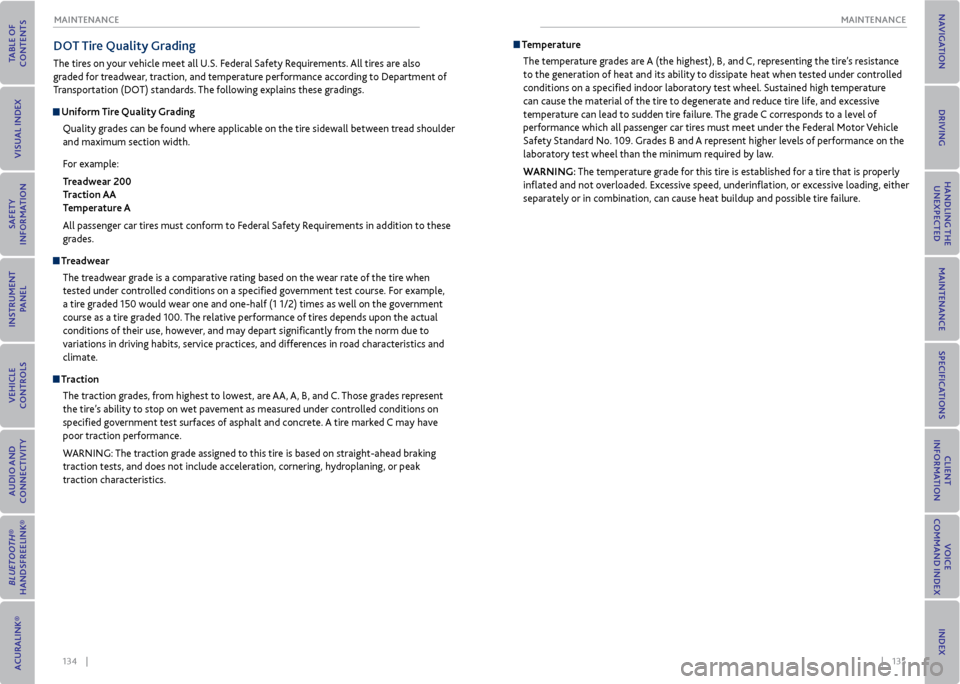
134 || 135
mAINTeNANCe
mAINTeNANCe
Do T Tire Quality Grading
The tires on your vehicle meet all U.S. Federal Safety Requirements. All tires are also
graded for treadwear, traction, and temperature performance according to Department of
Transportation (DOT) standards. The following explains these gradings.
Uniform Tire Quality Grading
Quality grades can be found where applicable on the tire sidewall between tread shoulder
and maximum section width.
For example:
Treadwear 200
Traction AA
Temperature A
All passenger car tires must conform to Federal Safety Requirements in addition to these
grades.
TreadwearThe treadwear grade is a comparative rating based on the wear rate of the tire when
tested under controlled conditions on a specified government test course. For example,
a tire graded 150 would wear one and one-half (1 1/2) times as well on the government
course as a tire graded 100. The relative performance of tires depends upon the actual
conditions of their use, however, and may depart significantly from the norm due to
variations in driving habits, service practices, and differences in road characteristics and
climate.
TractionThe traction grades, from highest to lowest, are AA, A, B, and C. Those grades represent
the tire’s ability to stop on wet pavement as measured under controlled conditions on
specified government test surfaces of asphalt and concrete. A tire marked C may have
poor traction performance.
WARNING: The traction grade assigned to this tire is based on straight-ahead braking
traction tests, and does not include acceleration, cornering, hydroplaning, or peak
traction characteristics.
TemperatureThe temperature grades are A (the highest), B, and C, representing the tire’s resistance
to the generation of heat and its ability to dissipate heat when tested under controlled
conditions on a specified indoor laboratory test wheel. Sustained high temperature
can cause the material of the tire to degenerate and reduce tire life, and excessive
temperature can lead to sudden tire failure. The grade C corresponds to a level of
performance which all passenger car tires must meet under the Federal Motor Vehicle
Safety Standard No. 109. Grades B and A represent higher levels of performance on the
laboratory test wheel than the minimum required by law.
WArNING: The temperature grade for this tire is established for a tire that is properly
inflated and not overloaded. Excessive speed, underinflation, or excessive loading, either
separately or in combination, can cause heat buildup and possible tire failure.
Page 78 of 79
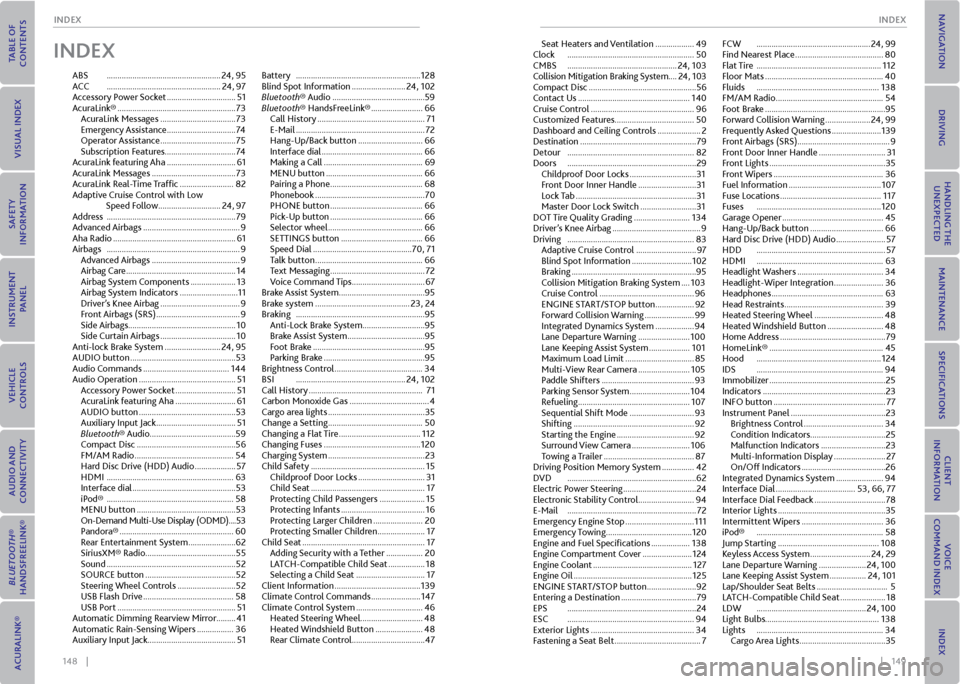
148 || 149
INDex
INDex
INDex
ABS ..................................................... 24, 95
ACC ..................................................... 24, 97
Accessory Power Socket ................................ 51
AcuraLink® ....................................................... 73
AcuraLink Messages ................................... 73
Emergency Assistance ................................ 74
Operator Assistance ................................... 75
Subscription Features .................................74
AcuraLink featuring Aha ................................ 61
AcuraLink Messages ....................................... 73
AcuraLink Real-Time Traffic ......................... 82
Adaptive Cruise Control with Low Speed Follow ............................. 24, 97
Address ............................................................ 79
Advanced Airbags ............................................. 9
Aha Radio ......................................................... 61
Airbags .............................................................. 9
Advanced Airbags ......................................... 9
Airbag Care ................................................... 14
Airbag System Components ..................... 13
Airbag System Indicators ........................... 11
Driver’s Knee Airbag ..................................... 9
Front Airbags (SRS) ....................................... 9
Side Airbags .................................................. 10
Side Curtain Airbags ................................... 10
Anti-lock Brake System .......................... 24, 95
AUDIO button ................................................. 53
Audio Commands ........................................ 144
Audio Operation ............................................. 51
Accessory Power Socket ............................ 51
AcuraLink featuring Aha ............................ 61
AUDIO button ............................................. 53
Auxiliary Input Jack ..................................... 51
Bluetooth® Audio ........................................59
Compact Disc .............................................. 56
FM/AM Radio .............................................. 54
Hard Disc Drive (HDD) Audio ................... 57
HDMI ........................................................... 63
Interface dial ................................................ 53
iPod® ........................................................... 58
MENU button .............................................. 53
On-Demand Multi-Use Display (ODMD) .... 53
Pandora® ..................................................... 60
Rear Entertainment System ...................... 62
SiriusXM® Radio.......................................... 55
Sound ............................................................ 52
SOURCE button .......................................... 52
Steering Wheel Controls ........................... 52
USB Flash Drive .......................................... 58
USB Port ....................................................... 51
Automatic Dimming Rearview Mirror .........41
Automatic Rain-Sensing Wipers ................. 36
Auxiliary Input Jack ......................................... 51Battery
.......................................................... 128
Blind Spot Information ......................... 24, 102
Bluetooth® Audio ...........................................59
Bluetooth® HandsFreeLink® ........................ 66
Call History .................................................. 71
E-Mail ............................................................ 72
Hang-Up/Back button .............................. 66
Interface dial ............................................... 66
Making a Call .............................................. 69
MENU button ............................................. 66
Pairing a Phone ........................................... 68
Phonebook ................................................... 70
PHONE button ........................................... 66
Pick-Up button ........................................... 66
Selector wheel ............................................ 66
SETTINGS button ...................................... 66
Speed Dial .............................................. 70, 71
Talk button .................................................. 66
Text Messaging ............................................ 72
Voice Command Tips .................................. 67
Brake Assist System ........................................95
Brake system ............................................ 23, 24
Braking ............................................................95
Anti-Lock Brake System .............................95
Brake Assist System ....................................95
Foot Brake ....................................................95
Parking Brake ...............................................95
Brightness Control ......................................... 34
BSI ................................................... 24, 102
Call History ..................................................... 71
Carbon Monoxide Gas ..................................... 4
Cargo area lights ............................................. 35
Change a Setting ............................................ 50
Changing a Flat Tire ...................................... 112
Changing Fuses ............................................. 120
Charging System ............................................. 23
Child Safety ..................................................... 15
Childproof Door Locks ............................... 31
Child Seat ..................................................... 17
Protecting Child Passengers ..................... 15
Protecting Infants ....................................... 16
Protecting Larger Children ....................... 20
Protecting Smaller Children ...................... 17
Child Seat ......................................................... 17
Adding Security with a Tether ................. 20
LATCH-Compatible Child Seat ................. 18
Selecting a Child Seat ................................ 17
Client Information ........................................ 139
Climate Control Commands ....................... 147
Climate Control System ............................... 46
Heated Steering Wheel ............................. 48
Heated Windshield Button ...................... 48
Rear Climate Control ..................................47 Seat Heaters and Ventilation ..................
49
Clock ........................................................... 50
CMBS ................................................... 24, 103
Collision Mitigation Braking System .... 24, 103
Compact Disc .................................................. 56
Contact Us .................................................... 140
Cruise Control ................................................ 96
Customized Features .....................................50
Dashboard and Ceiling Controls .................... 2
Destination ...................................................... 79
Detour ........................................................... 82
Doors ............................................................ 29
Childproof Door Locks ............................... 31
Front Door Inner Handle ........................... 31
Lock Tab ........................................................ 31
Master Door Lock Switch .......................... 31
DOT Tire Quality Grading .......................... 134
Driver’s Knee Airbag ......................................... 9
Driving ........................................................... 83
Adaptive Cruise Control ............................ 97
Blind Spot Information ............................ 102
Braking ..........................................................95
Collision Mitigation Braking System .... 103
Cruise Control ............................................ 96
ENGINE START/STOP button .................. 92
Forward Collision Warning ....................... 99
Integrated Dynamics System
.................. 94
Lane Departure Warning ........................ 100
Lane Keeping Assist System ................... 101
Maximum Load Limit ................................ 85
Multi-View Rear Camera ........................ 105
Paddle Shifters ........................................... 93
Parking Sensor System ............................ 104
Refueling .................................................... 107
Sequential Shift Mode .............................. 93
Shifting ........................................................ 92
Starting the Engine .................................... 92
Surround View Camera ........................... 106
Towing a Trailer .......................................... 87
Driving Position Memory System ............... 42
DVD ............................................................ 62
Electric Power Steering .................................. 24
Electronic Stability Control .......................... 94
E-Mail ............................................................ 72
Emergency Engine Stop ................................ 111
Emergency Towing ........................................ 120
Engine and Fuel Specifications .................. 138
Engine Compartment Cover ....................... 124
Engine Coolant .............................................. 127
Engine Oil ....................................................... 125
ENGINE START/STOP button ....................... 92
Entering a Destination ................................... 79
EPS ............................................................ 24
ESC ........................................................... 94
Exterior Lights ................................................ 34
Fastening a Seat Belt ........................................ 7FCW
..................................................... 24, 99
Find Nearest Place ......................................... 80
Flat Tire .......................................................... 112
Floor Mats ....................................................... 40
Fluids ......................................................... 138
FM/AM Radio .................................................. 54
Foot Brake ........................................................95
Forward Collision Warning ..................... 24, 99
Frequently Asked Questions ....................... 139
Front Airbags (SRS) ........................................... 9
Front Door Inner Handle ............................... 31
Front Lights ...................................................... 35
Front Wipers ................................................... 36
Fuel Information ........................................... 107
Fuse Locations ............................................... 117
Fuses .......................................................... 120
Garage Opener ............................................... 45
Hang-Up/Back button .................................. 66
Hard Disc Drive (HDD) Audio ....................... 57
HDD ............................................................ 57
HDMI ........................................................... 63
Headlight Washers ........................................ 34
Headlight-Wiper Integration ....................... 36
Headphones .................................................... 63
Head Restraints .............................................. 39
Heated Steering Wheel ................................ 48
Heated Windshield Button .......................... 48
Home Address ................................................. 79
HomeLink® ..................................................... 45
Hood .......................................................... 124
IDS ........................................................... 94
Immobilizer ...................................................... 25
Indicators ......................................................... 23
INFO button .................................................... 77
Instrument Panel ............................................ 23
Brightness Control ..................................... 34
Condition Indicators ................................... 25
Malfunction Indicators .............................. 23
Multi-Information Display ........................ 27
On/Off Indicators ....................................... 26
Integrated Dynamics System ...................... 94
Interface Dial ..................................... 53, 66, 77
Interface Dial Feedback ................................. 78
Interior Lights .................................................. 35
Intermittent Wipers ...................................... 36
iPod® ........................................................... 58
Jump Starting ............................................... 108
Keyless Access System ............................ 24, 29
Lane Departure Warning ...................... 24, 100
Lane Keeping Assist System ................. 24, 101
Lap/Shoulder Seat Belts ................................. 5
LATCH-Compatible Child Seat ..................... 18
LDW ................................................... 24, 100
Light Bulbs ..................................................... 138
Lights ........................................................... 34
Cargo Area Lights ........................................ 35